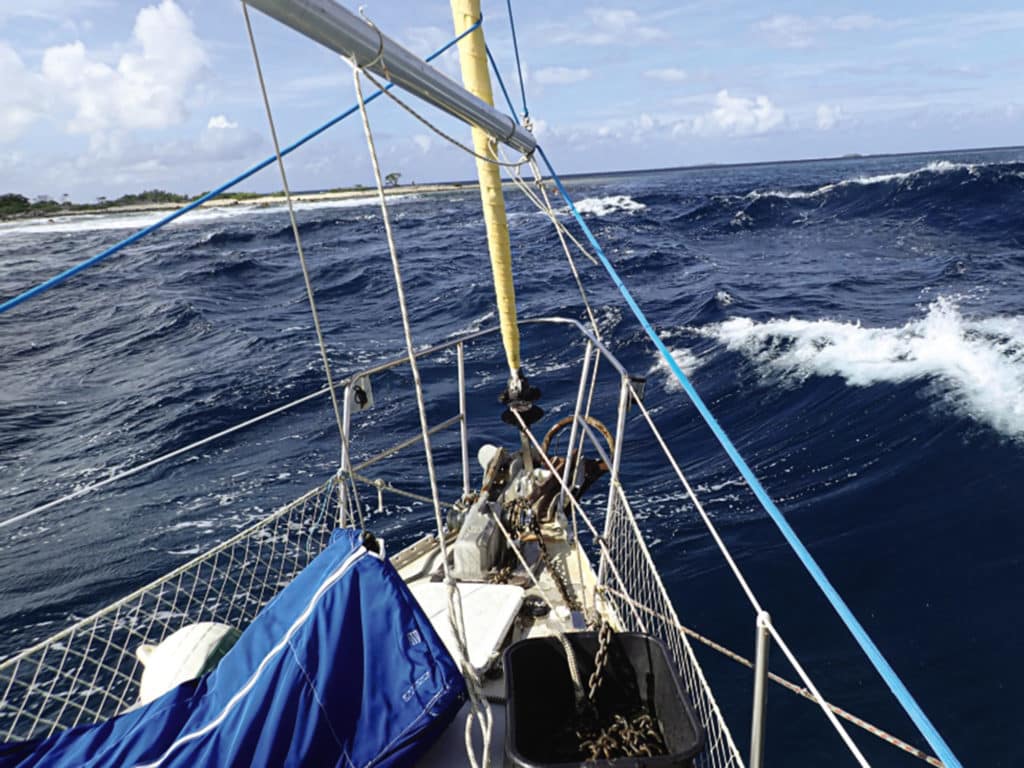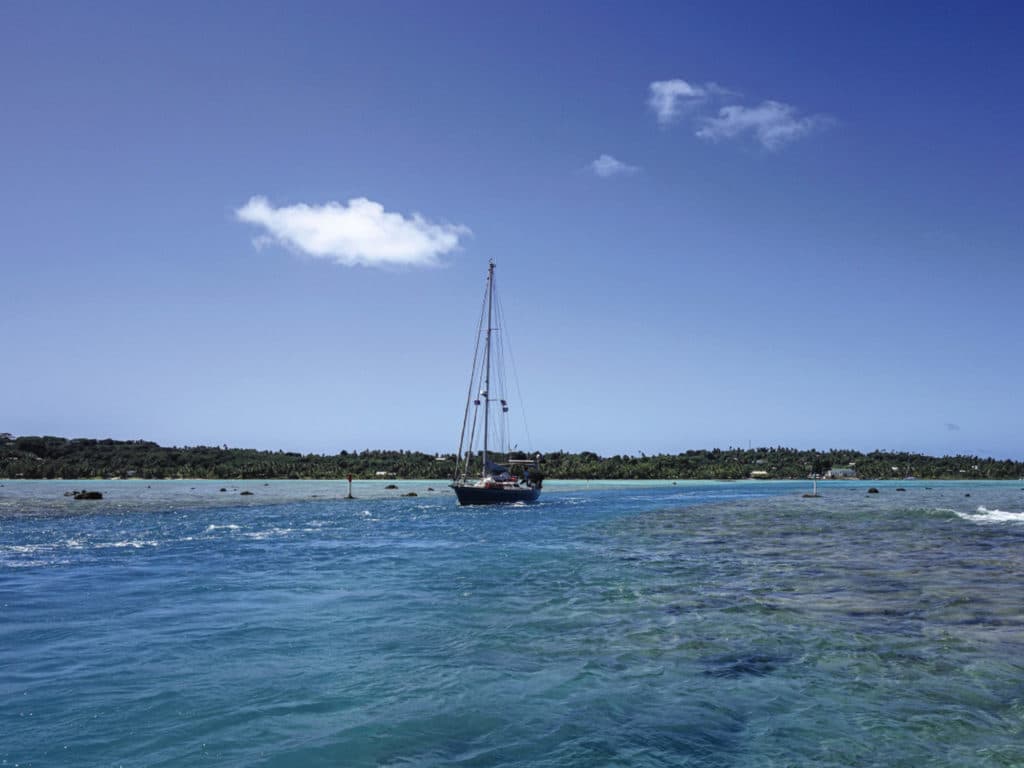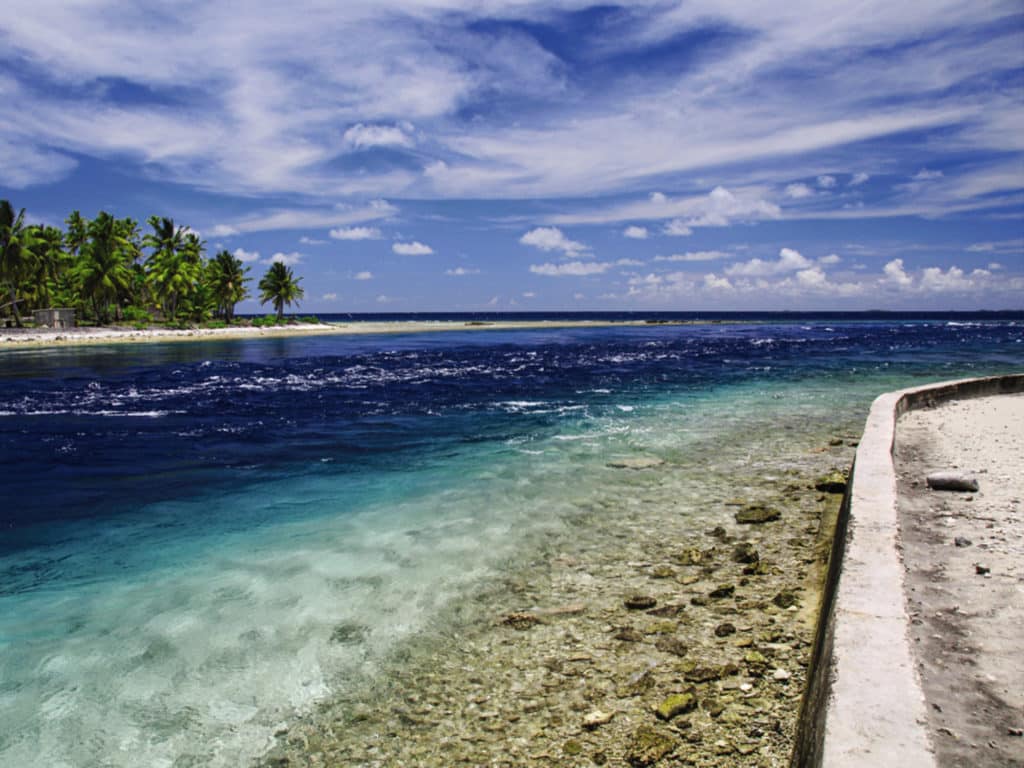
Before we entered our first reef pass in Tahanea, in the Tuamotu Archipelago of French Polynesia, we were quite anxious. We’d read several atoll-pass horror stories featuring punishing currents, breaking waves and dangerous eddies. To our surprise and relief, as we sailed toward Tahanea’s entrance, we found the broad pass laid before us at slack water with no visible threats. Our entry was entirely unspectacular. The weather was calm. We had arrived at the right time.
Predicting slack water in a lagoon pass is not always easy—atoll entry is a hot topic during South Pacific sailor sundowners and at beach barbecues. Different kinds of software tools designed to assist entries are passed around between boats. But often the data intended to help is completely off, particularly when the local seas run rough and the swell is high. Experienced cruisers and guidebook writers recommend rule-of-thumb slack-water estimates, but those estimates often yield contradictory results. Understanding how the tides inside a lagoon work can help avoid some nasty surprises.
During our eight seasons of cruising the South Pacific, we found generalizations such as “slack water can be found around high tide” should be taken with a grain of salt. Different lagoons can behave very differently. Lagoon-pass differences come primarily from the size of the lagoon and how well it is enclosed. For the following considerations here, we ignore the influence of a local high swell and assume calm conditions.
Imagine an open lagoon with several wide passes. Such a lagoon behaves basically like a bay, where the water level follows the tides immediately. In this case, slack water would generally occur in a pass at high water and again at low water. The current comes in during the rising (or flood) tide and flows out when the tide is falling (ebb tide).
The situation is entirely different when a lagoon is well-enclosed. Consider a lagoon with a high reef around it and a tiny pass that can carry only a small amount of water. Such a small amount of water exchange does not alter the water level in the lagoon considerably. If the lagoon behind a small pass is huge, the water level remains basically constant and no tides can be observed inside. The pass will have an incoming current whenever the ocean is higher than the lagoon (strongest around high water) and an outgoing current when the ocean is lower (strongest around low water).
In a closed lagoon, slack water occurs at the midpoint between high and low tide, when ocean and lagoon levels are the same. Just as a river always runs downhill, at the same hour an open lagoon has slack water, the pass of a neighboring closed lagoon has the strongest currents.
Most of the atolls in the Tuamotus are somewhere between these two extremes. The passes cannot fully level out the tidal changes in an open lagoon, but the amount of transported water is enough to cause the lagoon levels to rise and fall. The tidal range inside a lagoon is smaller than outside, and the tidal cycle inside the lagoon lags behind the ocean tides. If ocean swell is not a variable, slack water can be found when the lagoon has a high or low tide. Depending on how closed the atoll is, this might happen up to three hours after the high (or low) water of the outside ocean.

When ocean swell or wind waves reach a certain height, they start breaking over the barrier reef and transport water into the lagoon. Walking along motus during rough weather is interesting because one can clearly observe riverlike streams in the channels between the motus. The barrier is typically high enough for these streams to be one-way, regardless of the tide. This extra amount of water has to find its way out of the lagoon through the pass(es), adding extra current. Depending on the capacity of the pass(es), the lagoon dams up to a certain level. In a rather open lagoon, this might be just a few centimeters, but in a closed one, it can reach several feet. We spent a lot of time in Pacific atolls such as Maupihaa, in the Society Islands, and Raraka, in the Tuamotus. During high-swell periods, we could clearly observe such raised water levels on these islands with tiny passes. All the beaches and even some of the motus were flooded for days.
The increased lagoon level changes the times for slack water in the passes considerably. As the level rises, the phase with incoming current becomes shorter, while the phase with outgoing current gets longer. This occurs until, from a certain level on, the incoming phase ceases altogether. The current in the pass flows out regardless of the tide; moments of slack water disappear. In such a scenario, the current in a closed lagoon is weakest when the ocean reaches high tide, and in an open lagoon after the middle of the rising tide.
Although an engine might help the skipper navigate a tricky pass, the risks of relying solely on the engine for safe passage are steep. In our years of cruising atolls, we have met more than one captain with his 50- or 60-footer on the hard for rudder repairs after a reckless pass transit. Keep in mind that the current might be too strong to motor against; standing waves can be brutally steep and high, particularly when the wind blows hard against the current. Hidden eddies can turn the transit into a roller coaster. To minimize the risks, a pass transit should be attempted at or near slack water, when little or no current flows.
Ideally, there should be no amplified waves and no visible eddies. A tide table of the lagoon or a nearby landmark can help, but note that the tables are for the high- and low-water times of the ocean, not the lagoon. In a closed lagoon, the tides can be delayed by up to three hours. Some places such as Rangiroa can be predicted, while others—such as Hao, in the eastern Tuamotus—cannot. Check slack-water times with sailors and locals inside the lagoon via VHF radio, and ask around for personal experience of the area via single-sideband radio nets.

We always try to arrive at a pass early in the morning in order to observe the pass and determine whether the current is going in or out. When the current flows out, waves and agitated water are apparent outside the pass, sometimes up to a mile out. When the current goes in, the boiling water can be seen inside. If the waves are steep and high, we wait for the current to slacken. With an early arrival, there is no rush: We can wait for good conditions and a safe entry. During rough periods with high waves and swell, the best time to attempt the pass is about two hours before high tide. If we’re anchored inside a protected lagoon and the seas are building, we prefer to stay put and delay the next passage until the seas have calmed down.
The current is usually strongest and the waves highest in the deepest section of the pass. Although it is tempting to approach the pass on its leading line and stay in what feels like the safe center, this is exactly where the witch’s cauldron bubbles the hottest. If the pass is wide enough, we try to stay to one side and attempt to sneak through without getting bashed. Sailing in or out of a lagoon smoothly gets easier with experience, but approaching an unknown pass is always an exciting moment.
Birgit Hackl and Christian Feldbauer departed the Mediterranean in 2011, sailing via the Atlantic and Caribbean to the South Pacific. They’ve explored Tonga and the Cook Islands, but their favorite cruising ground is French Polynesia. For more information, visit their blog.








